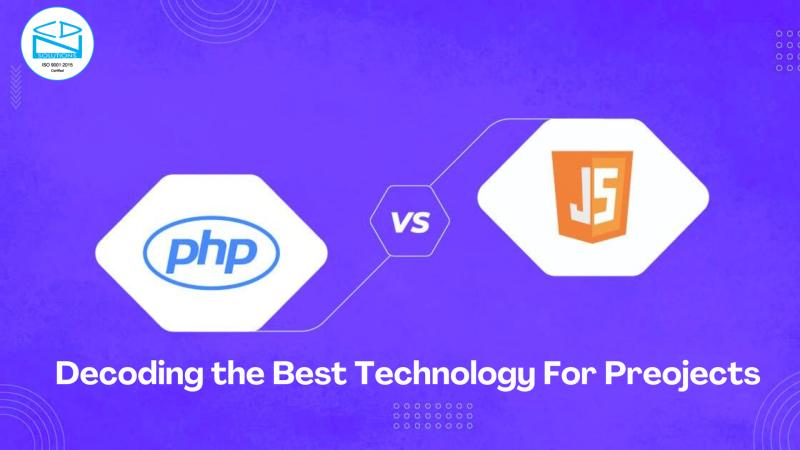PHP vs Java Script: Decoding The Best Technology For Web Development

While Developing a new web technology choosing the right programming language can significantly impact your project's work if we watch out for today's time the top contenders are PHP and JavaScript each has its unique advantages, strengths, and weaknesses. In the blog, we will provide an in-depth comparison of these two technologies, helping you make the right choice for your client's project.
What is PHP
PHP, or hypertext preprocessor, is one of the most powerful tools for web app solutions. Rasmus Lerdorf created PHP 30 years ago, in the year 1994. PHP is the embedding of HTML for creating dynamic and interactive web pages. Now PHP has a really big community, extensive libraries, and frameworks, making web development very easy.
What Is JavaScript
Brendan Eich created this highly dynamic programming language in the good year of 1995. It became famous for its dynamism and interactivity with web pages. JavaScript is a high-level, dynamic programming language primarily used to create interactive effects within web browsers. As a core technology of the World Wide Web, it enables client-side scripting, making web pages more dynamic and engaging. Some of the top javascript frameworks are Angular.js, Vue.js, and Express.js.
Key Differences While Choosing Technologies for Web Development
1. Execution Environment
PHP: Runs on the server. When a user requests a page, the server processes the PHP code and sends the resulting HTML to the client’s browser.
JavaScript: Runs on the client-side, in the user’s browser. It can manipulate the HTML and CSS of a page after it has been loaded, providing real-time interaction.
2. Purpose and Use Cases
PHP: Primarily used for server-side tasks such as database interaction, session management, and server-side logic. It excels in building back-end applications and server-side APIs.
JavaScript: Used for enhancing user interfaces, creating interactive web applications, and handling client-side validation. It is essential for front-end development and is increasingly used on the server-side with frameworks like Node.js.
3. Syntax and Learning Curve
PHP: Generally considered easy to learn for beginners, especially those familiar with HTML. Its syntax is straightforward and designed for web development.
JavaScript: Slightly more complex due to its asynchronous nature and the concept of closures. However, its syntax is also relatively easy to grasp, particularly for those with a background in C-style languages.
4. Frameworks and Libraries
PHP: Popular frameworks include Laravel, Symfony, and CodeIgniter, which streamline development and offer robust solutions for common tasks.
JavaScript: Numerous frameworks and libraries like React, Angular, and Vue.js dominate front-end development, while Node.js and Express.js are popular for back-end development.
5. Performance
PHP: Generally slower than JavaScript when it comes to execution speed, but performance can be optimized through caching and effective coding practices.
JavaScript: Often faster in processing due to its client-side execution. With advancements like Just-In-Time (JIT) compilation in engines like V8, performance has improved significantly.
6. Development Speed and Ease of Use
PHP: PHP is easy to use and learn. It also exposes a large array of libraries, built-in functions, and different frameworks that speed up the development process.
JavaScript: Again, this can be used for both the front end and the back end. The learning curve can get steeper because of this. Moreover, the asynchronous nature of Javascript can further add to its complexity.
In Which Scenarios This Technologies Used
For PHP
- When building a server-side application or a CMS.
- If your project needs to interact with a relational database (e.g., MySQL).
- This is for projects requiring strong back-end support and security features.
FOR JAVASCRIPT
- For creating interactive and dynamic user interfaces.
- When you need real-time updates without reloading the page (e.g., single-page applications).
- For full-stack development using JavaScript frameworks on both client and server sides.
Conclusion
Both PHP and JavaScript have their own strengths and weaknesses, catering to different aspects of web development. The choice between them depends on your project requirements, team expertise, and long-term goals.
If your focus is on server-side development, PHP remains a strong choice. However, if you’re looking to create rich, interactive web applications, JavaScript is the way to go.
Detailed research should be carried out before you finally decide to hire PHP developers or approach a JavaScript development company for your project to avoid hassle or backwardness.
To Know More About Which Technology You Should Prefer Hire a web development company CDN Solutions to give a boost to your growth with its expertise and experience. As a leading software development company, we help you through all the nooks and corners while picking up a live language for your project. It will also help with expert development services in bringing your ideas into reality.









Comments